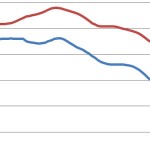Toward a Consistent Philosophy on Guns and Assisted Suicide
Just as I settled in to write this post on a very different matter, I spotted news that the Vegas killer was prescribed an anti-anxiety medicine in June. As Columbia University psychiatric medicine professor Michael First warned The Hill, the information available doesn’t tell us whether the drug had a causal influence on his attack or some prior cause led to both the prescription and the massacre. Nonetheless, some Americans will reasonably turn their thoughts to limiting access to guns for people on medications indicating psychological problems. (Note that I’m calling the thought “reasonable,” not agreeing with the conclusion.)
Given that the topic about which I set out to write was assisted suicide, I wondered what overlap a Venn diagram would show between Americans who would support withholding guns from people with psychological prescriptions and Americans who support giving the same population access to suicide drugs.
[box type=”note” style=”rounded”]To Our Readers: We need your support to challenge the progressive mainstream media narrative. Your donation helps us deliver the truth to Rhode Islanders. Please give now.[/box]
Obviously, the connection I’m drawing isn’t ideal. The Nevada psycho killed other people, whereas the suicidal generally kill only themselves. The connection comes if we add to the Venn diagram people who would encourage the suicidal to refrain from buying guns and then if we read this Catholic News Agency article about J.J. Hanson, who was diagnosed three years ago with terminal brain cancer:
“I would have easily met the criteria for accessing assisted suicide if I lived in a state like Oregon or California, where assisted suicide is legal,” Hanson said.
“In a dark moment, I might have opted for it, but I am fortunate to have a supportive family, and was given the opportunity to pursue cutting edge, experimental treatment instead,” he said. “Here I am three years later, enjoying the arrival of our second son and living life to the fullest.” …
“When assisted suicide becomes accepted public policy it threatens the lives of everyone, especially the poor, elderly, mentally ill, disabled, and terminally ill,” he said. “Why? Well, for starters, abuse is unavoidable and doctors are fallible. Assisted suicide policy also injects government insurers and private insurance companies with financial incentives into every single person’s end of life decisions.”
Watching the accompanying video drives home the point that suicide doesn’t just hurt the person who takes his or her own life; the key point, though, is that we instinctively understand that we should keep harmful things away from those who might hurt themselves or others. Of course, such policies are all about balance, and we can discuss whether the right to bear arms overwhelms a reasonable urge to keep weapons out of the hands of vulnerable or dangerous people, on the one hand, and the right to self determination overwhelms a justified social sanctification of life.
I don’t get the sense, however, that people are accustomed to breaking these emotional issues down to their core components and considering whether their discrete views on this or that matter are fundamentally consistent.



